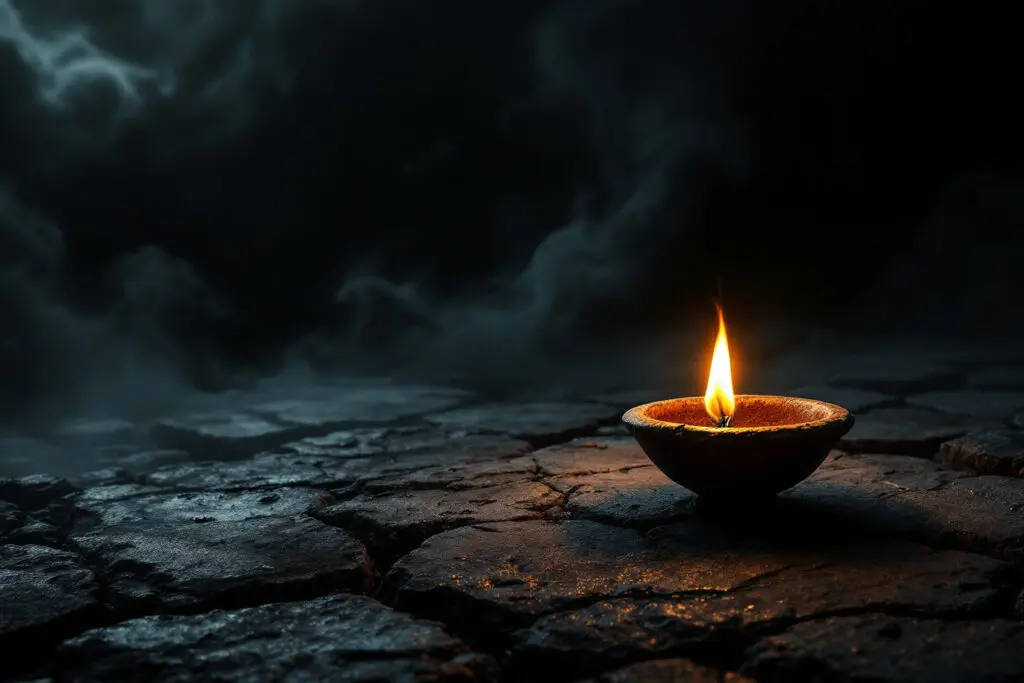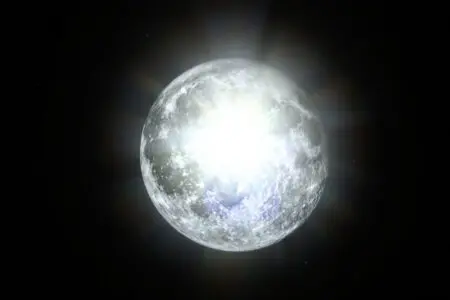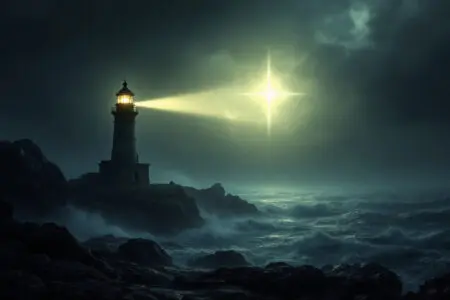Have you ever been somewhere truly dark? I don’t mean a room with the lights off. I’m talking about a deep, consuming darkness, the kind you find in a cave or on a country road with no moon. It’s a blackness so total you can feel it pressing in. In that kind of oppressive void, what happens when you strike a single match?
That tiny flame doesn’t just meekly appear. It explodes. It dominates the space, pushing the darkness back in an instant. This is the exact, powerful image the Apostle John paints in one of the Bible’s most potent verses. Getting to the heart of the John 1:5 meaning is like striking that match in our own confusion and struggles. It’s a raw promise of hope, an unbreakable declaration of victory that speaks directly into the chaos we all face.
The verse itself is stunningly simple: “The light shines in the darkness, and the darkness has not overcome it.” But don’t let the simplicity fool you. Packed into those few words is a universe of meaning. This isn’t just a line of poetry; it’s the foundational truth of John’s entire Gospel, setting the stage for the epic struggle between light and darkness, truth and lies. More than that, it declares the winner before the fight even begins.
More in John Chapter 1 Category
Key Takeaways
- The Light Is Jesus: In John’s Gospel, the “Light” isn’t a metaphor for goodness. It’s a title for a person: Jesus Christ, the divine Word (Logos) who stepped into our world.
- Darkness Is an Active Force: The “darkness” isn’t just the absence of light. It represents a world in active rebellion against God—a system of sin, spiritual blindness, and opposition to truth.
- The Shining Is Constant: The Greek verb for “shines” is in the present tense. This is crucial. It means the light shines continuously, relentlessly, right now. It never stops.
- Victory Is an Unbreakable Promise: The Greek word for “overcome” cleverly means both “to conquer” and “to comprehend.” The darkness can neither extinguish the light nor understand it, guaranteeing Christ’s ultimate and final triumph.
So, What Exactly Does John Mean by “The Light”?
When John kicks off his Gospel, he’s not just setting a scene. He’s making a massive philosophical and theological claim. He starts with that thunderous phrase, “In the beginning was the Word, and the Word was with God, and the Word was God.” This “Word”—Logos in Greek—is God’s ultimate self-expression. Then, in verse 4, he links the Word directly to our theme: “In him was life, and that life was the light of all mankind.”
So, by the time we hit verse 5, there’s zero doubt. The “light” is not some fuzzy, abstract idea of hope.
The Light is a person. It is Jesus Christ.
He is the perfect, living explanation of who God is. How could we possibly grasp an infinite, invisible God? We couldn’t. So God sent His Son, the Word made flesh, to be the Light for us. Jesus turned on the lights, illuminating God’s true character—His radical love, His fierce holiness, His perfect justice, and His breathtaking mercy. For centuries, humanity had been fumbling in the dark, making educated guesses and crafting flawed idols. Jesus walked into history and showed us the real thing.
This isn’t a passive, gentle glow like a distant star. This is an active, life-giving, and revealing light. It exposes things for what they truly are. It shows us the path forward. In the same way physical light lets our eyes see reality, the spiritual light of Christ lets our souls see the reality—our desperate need for God and His incredible plan to save us.
And What Is This “Darkness” the Light Shines Into?
If Jesus is the Light, then what exactly is this darkness? It’s vital to grasp that biblically, darkness is more than just an empty space waiting for a lamp. It’s an active, hostile environment. It’s the spiritual condition of a world that has fundamentally turned away from its Creator. It is the realm of sin, willful ignorance, deception, and death.
This darkness is marked by a few key things:
- Spiritual Blindness: It’s a profound inability to see or recognize spiritual truth. The Apostle Paul gets right to the point, saying “the god of this age has blinded the minds of unbelievers, so that they cannot see the light of the gospel” (2 Corinthians 4:4).
- Moral Rebellion: It’s a world system where right and wrong are constantly being twisted, where evil is justified and goodness is mocked. It’s the culture of pride and self-interest that stands in direct opposition to God’s ways.
- Hostile Opposition: The darkness doesn’t sit idly by. It fights back. It despises the light. As John himself says later, “people loved darkness instead of light because their deeds were evil” (John 3:19). The light acts like a disinfectant, exposing the rot of sin, and the darkness recoils violently to protect itself.
I remember a period in my early twenties where I felt totally lost. I’d made a string of bad choices that pushed away the people who cared about me, and I was stuck in a dead-end job that was crushing my spirit. It felt like a physical weight, a tangible darkness that had just settled on my life. It wasn’t just being sad; it was a deep, gnawing meaninglessness. A spiritual blindness. I couldn’t see a single good path forward. That feeling is a perfect snapshot of the darkness John talks about—a life cut off from the Source of all Light, where everything fades to gray. It’s into that kind of profound, personal darkness that Jesus promises to shine.
How Does the Light Actually “Shine” in the Darkness?
The specific Greek word John picks for “shines” is phainei. This is a huge deal. It’s in what’s called the present active indicative tense. You don’t need a grammar lesson to get the punchline: it means this is happening right now, and it never stops. It’s a continuous, ongoing action.
The light didn’t just shine once in the past. It isn’t just going to shine someday in the future. It shines. Now. Always.
This isn’t a flickering candle. It’s a steady, relentless sunbeam that slices through the deepest gloom.
The life of Jesus—His birth, ministry, death, and resurrection—was the ultimate moment of this light crashing into the world’s darkness. But the shining didn’t stop when He ascended. He continues to shine today through His Word, the Bible. He shines through the Holy Spirit who lives in those who trust Him. He shines through the love and service of His people. The light is always pressing in, always invading, even when the darkness feels suffocating. It is an active, unstoppable force, forever breaking into enemy territory.
This persistent, aggressive nature of the light gives the verse its raw power. It doesn’t promise that the darkness will just vanish. No, it says the light shines in the darkness. They exist in the same space for a time. But the momentum is always with the light. The light is the one on the offensive. The darkness is only ever reacting—and as we’re about to see, its reaction is completely hopeless.
What Does It Mean That the Darkness “Has Not Overcome It”?
Here we go. This is the clincher. This is the declaration of victory shouted from the rooftops. And what’s fascinating is that the Greek word John uses, katelaben, has a brilliant double meaning. Both are true, and together they give the verse an incredible depth.
First, The Darkness Can’t “Comprehend” It
One perfectly valid translation of katelaben is “to grasp” or “to understand.” In this sense, John is saying the darkness is intellectually and spiritually incapable of figuring the light out. The core motivations of the Light—self-sacrificial love, grace, mercy, forgiveness—are a foreign language to the darkness, which only understands power, selfishness, and pride.
Look at it from the enemy’s perspective during Jesus’s ministry. They were baffled by Him. They saw his miracles and tried to force him into a political box. They heard his teaching and accused him of insanity and blasphemy. They witnessed his compassion and plotted his execution. They thought they had finally snuffed out the Light on a Roman cross, certain that their dark tools of violence and betrayal had won the day.
They just couldn’t get it. They couldn’t comprehend that the cross wasn’t their victory, but His. They couldn’t grasp that through death, Jesus would shatter the power of death itself. The darkness, in its arrogance and blindness, is simply unable to compute the reality of the light.
Second, The Darkness Can’t “Conquer” It
The more common and direct translation of katelaben is “to overtake,” “to overwhelm,” or “to extinguish.” This is the meaning you’ll see in most modern Bibles: “the darkness has not overcome it.”
This is a flat-out promise of invincibility.
Imagine trying to put out a forest fire with a squirt gun. It’s absurd. You can’t fight something so powerful with something so pathetic. In the same way, the darkness can launch its full assault on the light of Christ. It can inspire persecution. It can spread lies. It can stir up chaos. At times, it can even create the illusion that it’s winning.
But it can never, ever put out the light.
The cross was the moment the darkness played its trump card. For three hours that Friday, a supernatural darkness covered the land. The Light of the World hung dead on a cross and was sealed in a black tomb. The darkness had its moment. It did its absolute worst.
And it wasn’t enough.
On the third day, the Light exploded from that tomb, brighter and more powerful than ever. The resurrection is the final, irrefutable proof. The darkness threw its best punch, and it couldn’t overcome the light. It never will.
How Does This Single Verse Connect to the Bigger Biblical Story?
John 1:5 isn’t some random, isolated thought. It’s a brilliant summary of a theme that weaves its way from Genesis to Revelation. John knew his audience would immediately hear the echoes of their own Scriptures.
Is This a Throwback to Creation in Genesis?
Without a doubt. What is the very first thing God does in Genesis 1:3? He speaks: “Let there be light.” Light is what God uses to separate order from chaos. It’s the prerequisite for life. John deliberately mimics that creation language. By starting with “In the beginning was the Word,” he’s yanking us back to Genesis 1. He’s making a bold statement: the same God who brought physical light into the void has now, through Jesus, brought spiritual Light into our fallen world. This is a new creation. You can explore more on the parallels between Genesis and John’s prologue on educational sites like those from Dallas Theological Seminary.
Doesn’t the Old Testament Predict This Great Light?
Powerfully so. The prophet Isaiah, speaking centuries before Jesus to a nation suffocating in spiritual and political darkness, delivered this stunning prophecy: “The people walking in darkness have seen a great light; on those living in the land of deep darkness a light has dawned” (Isaiah 9:2).
Every Jewish person in Jesus’s time knew this verse. They were holding their breath, waiting for this “great light.” John’s Gospel lands like a thunderclap, declaring, “The wait is over. The prophecy is fulfilled. Jesus is that great light.”
How Can the John 1:5 Meaning Impact Our Real Lives?
This is where it gets real. It’s one thing to dissect a verse in theory. It’s another to let its truth change how you walk through your day.
Years ago, I was part of a volunteer team helping clean up after a brutal flood had wrecked a small town. The sense of hopelessness was a physical thing you could taste in the air. People had lost everything. The mud, the debris, the ruin—it was a literal and emotional darkness. In the middle of this chaos, a small church from out of state set up a big barbecue trailer and just started giving away hot meals. They didn’t preach sermons; they just served brisket sandwiches.
It was a small act in the face of a massive tragedy.
But it was light. That simple, tangible act of love and hope sliced right through the despair. It was a defiant shout that these people were not forgotten. For me, that was John 1:5 in action. The darkness of the disaster was real and terrible. But that small, stubborn light of selfless love refused to be overcome by it.
What Do You Do When You’re Facing Personal Darkness?
When you are personally wrestling with fear, grief, anxiety, or doubt, John 1:5 becomes your lifeline. It is a reminder that your struggle, as real as it feels, is not the ultimate reality. The Light is. Your feelings of being overwhelmed cannot actually extinguish the presence of Christ in your life.
Here’s how to hold on to it:
- Declare the Truth: Say it out loud. “The light shines in the darkness, and the darkness cannot overcome it.” Speaking truth shifts your focus from the size of your darkness to the power of His Light.
- Scan for Light: Even on the worst days, train your eyes to look for evidence of God’s presence. It might be the unexpected kindness of a stranger, a line in a song, a moment of unexplainable peace. The light is always shining somewhere.
- Take a Step: Just one small step toward the light is a victory. One prayer. One right choice. One moment of gratitude. Each step you take toward Him makes the darkness recede.
How Should We Respond When the World Feels Overwhelmingly Dark?
Turn on the news for five minutes, and it’s easy to feel like the darkness is winning. Division, hatred, suffering—it can feel like a tidal wave. John 1:5 is God’s direct answer to that feeling. It’s His promise that He is still in control and His plan will not be derailed. The Light wins in the end.
That truth doesn’t just save us from despair; it empowers us to act. We aren’t called to sit around and curse the darkness. We are called to be lights in it. Every act of integrity, every word of encouragement, every prayer for an enemy, every hand extended to the person who has fallen—each one is like turning up the dimmer switch of God’s light in the world. You become a small reflection of the great Light, a defiant act of hope that the darkness can never, ever stamp out.
Does This Verse Promise a Life Free From Struggle?
This is so important. Notice what John 1:5 doesn’t say. It doesn’t say, “The light has eliminated the darkness.” It doesn’t promise that following Jesus is a ticket to a life free from pain, hardship, or confusion.
It says the light shines in the darkness.
This is a truth for the trenches. It’s a promise for real people fighting real battles in a very broken world. The presence of struggle in your life is not proof of the absence of the Light. The two coexist on this side of eternity. The fight is real, and sometimes the darkness will feel incredibly close.
But the promise of this verse is the final word. The darkness has a leash. It can bark, but its chain is short. It can threaten and roar, but it cannot conquer. It can surround, but it cannot extinguish. The final outcome of the war between light and darkness was decided at the cross and the empty tomb. We are simply living out our part in the battle, absolutely secure in who holds the ultimate victory.
The light is shining. It has never stopped shining. And the darkness can do nothing to stop it. That is the unbreakable hope of John 1:5.
FAQ – John 1:5 Meaning

How does the Greek word used for ‘shines’ in John 1:5 emphasize the nature of Christ’s light?
The Greek word ‘phainei’ used for ‘shines’ is in the present tense, highlighting that Christ’s light is ongoing and relentless, continuously illuminating the world regardless of circumstances.
What does the verse imply about the nature of darkness?
The verse indicates that darkness is an active force characterized by spiritual blindness, rebellion, and opposition to God’s truth, but it cannot defeat or comprehend the eternal Light.
Who is the Light referred to in John 1:5?
The Light referred to in John 1:5 is Jesus Christ, who is portrayed as the divine Word and the ultimate revelation of God’s character.
What is the central message of John 1:5?
The central message of John 1:5 is that the light, represented by Jesus Christ, continually shines in a world engulfed in darkness, and that darkness has not, and will not, overpower or understand it.





